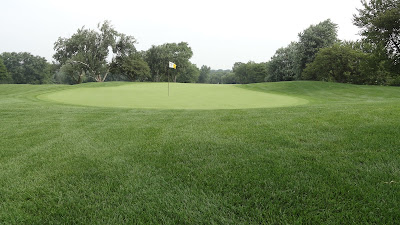What do you call a turfgrass disease that occurs during the summer months and shows itself in the form of reddish-brown patches? Summer Patch. The symptoms of this disease have been showing for 2 weeks now. The weather conditions have been perfect for this disease to continue to spread throughout that time. The pathogen that causes this disease is in the soil and becomes active during periods of high soil temperatures and wet weather. We have has plenty of both the last 14 days. Soil temperatures have regularly been over 80 degrees, and we have received just short of 7 inches of rain in that time. The extremely hot temperatures before this stretch certainly weakened the root system which made them more susceptible to infection. It's no coincidence that this topic was talked about last year in Intermediate Cut and Walkways.
Why only in the roughs? This disease does not infect creeping bentgrass, the dominate grass in our fairways. There are places where the annual bluegrass in the fairways is showing symptoms. This is evident in the fairways with the most annual bluegrass - 5, 8 and 9 fairways. This disease is difficult and expensive to control because it is a soil pathogen. Because of the cost, this disease is not in our control program.
Why only parts of the roughs? It is evident to you that some areas are worse than others. This disease can be worse in areas that are more poorly drained or compacted from traffic. These two situations will result in a less vigorous root system, that will result in more damage when the plant is infected. This picture shows a different situation. This is a picture of the red tee on 6. You can see a strip of grass from the front of the tee to the bottom right of the picture that has no disease. This area was sodded during the renovation project, while everything around it was seeded.
Many areas are showing no symptoms at all. This is probably the result of no traffic from carts in these areas and better drainage. This will create a healthier plant, and better soil conditions for rooting.






0 comments:
Post a Comment